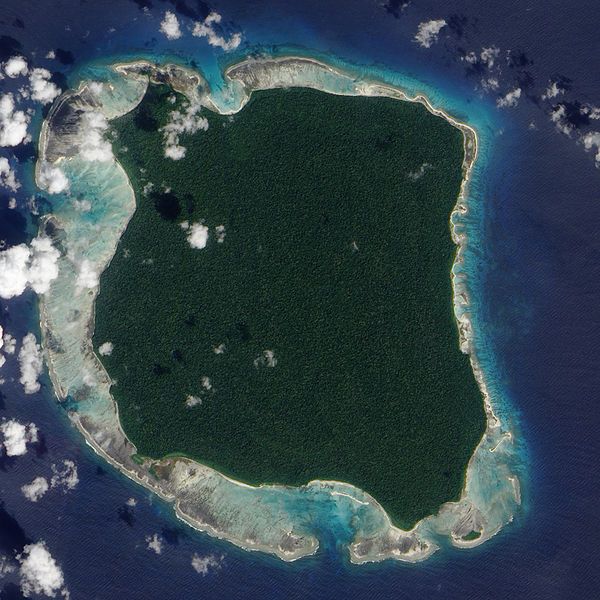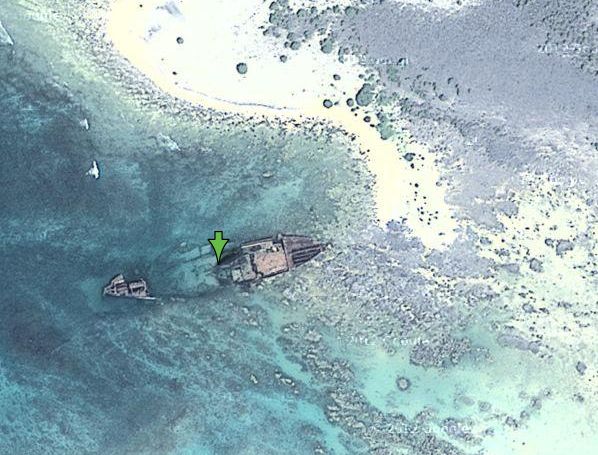 The following is an article from Uncle John's 24-Karat Gold Bathroom Reader.
The following is an article from Uncle John's 24-Karat Gold Bathroom Reader.
Ever heard of North Sentinel Island? Probably not …even thought's one of the most unusual places on Earth. What makes it so odd? The people -they've been there a long time, completely cut off from the rest of the world.
MAROONED
Late on the night of August 2, 1981, a Hong Kong freighter navigating the choppy waters of the Bay of Bengal ran aground on a submerged coral reef. The ship, called the Primrose, was hopelessly stuck. But there was no danger of it sinking, so after radioing for assistance, the captain and crew settled in for a few days' wait until help arrived.
The following morning, as it became light, the sailors saw an island a few hundred yards beyond the reef. It was uninhabited, as far as anyone could tell: There were no buildings, roads, or other signs of civilization there -just a pristine, sandy beach and behind it, dense jungle. The beach must have seemed like an ideal spot to wait for a rescue, but the captain ordered the crew to remain aboard the Primrose. It was monsoon season, and he may have concerned about lowering the men into the rough sea in tiny lifeboats. Or perhaps he'd figured out just which tiny island lay beyond the reef: It was North Sentinel -the deadliest of the 200 islands in the Andaman Island chain.
SOME WELCOME
A few days later, a lookout aboard the Primrose spotted a group of dark-skinned men emerging from the jungle, making their way toward the ship. Was it the rescue party? It seemed possible …until the men came a little closer and the lookout could see that every one of them was naked.
Naked …and armed, but not with guns. Each man carried either a spear, a bow and arrows, or some other primitive weapon. The captain made another radio distress call, this one much more urgent: "Wild men! Estimate more than 50, carrying various homemade weapons, are making two or three wooden boats. Worrying they will board us at sunset."
A WORLD APART
 (Image credit: Captain Robert Fore)
(Image credit: Captain Robert Fore)
After a tense standoff lasting a few more days, the crew of the Primrose were evacuated by helicopter to safety. They were lucky to get away: It was their misfortune to have run aground just offshore of one of the strangest islands on Earth, and probably the very last of its kind. Anthropologists believe the men who appeared on the beach that morning in 1981 are members of a hunter-gatherer tribe that has lived on the island for 65,000 years. That's 35,000 years before the last ice age, 55,000 years before the great woolly mammoths disappeared from North America, and 62,000 years before the ancient Egyptians built the pyramids at Giza. These people are believed to be the direct descendants of the first humans out of Africa.
The outside world has known about North Sentinel Island for centuries, but the islanders have been almost completely cut off from the rest of the world all that time, and they fiercely maintain their isolation to this day. No one knows what language they speak or what they call themselves -they have never allowed anyone to get close enough to find out. The outside world calls them the "Sentineli" or the "Sentinelese," after the island. It's estimated the the 28-square-mile island (slightly larger than Manhattan) is capable of supporting as many as 400 hunter-gatherers, but no one knows how many people live there.
HOME ALONE
North Sentinel Island is amazingly well suited to both support and isolate a tribe like the Sentinelese. It's too small to interest settlers or colonial powers, especially when there are bigger, better islands within a few hours' sailing time. And unlike many of those islands, North Sentinel has no natural harbors, so there's no good place for a ship to take shelter from a storm. Furthermore, the island is surrounded by a ring of submerged coral reefs that prevent large ships from approaching. This was especially true during the age of sail, when ships had no way of quickly maneuvering out of harm's way once they realized that the reefs were there. Narrow openings in these reefs allow small boats to slip through and land on the beach, but these are passable only in good weather and calm seas, which occur as infrequently as two months out of the year. For the remaining ten months, the island cannot be safely approached from the sea.
SELF-SUFFICIENCY
 (Image credit: Flickr user Christian Caron)
(Image credit: Flickr user Christian Caron)
At the same time that they keep strangers out, the coral reefs help keep the Sentinelese in, because the reefs create several shallow lagoons that are teeming with sea life. The food provided by these lagoons is so plentiful that the Sentinelese have never needed to fish in the deep sea waters beyond the coral reefs. They propel their dugout canoes through the shallow lagoons by poling along the bottom, but they cannot navigate in water deeper than the length of the poles. They've never invented oars, without which they cannot leave the island.
The Andaman Islands, North Sentinel included, sit at the crossroads of ancient trade routes between Europe, the Middle East, and Southeast Asia. Ironically, this may have further encouraged the isolationist tendencies of the Sentinelese, because their dark skin and African appearance would have made them the targets of any slave traders who might have tried to land on the island over the centuries. Periodic contact with such outsiders would have only intensified the tribe's hostility toward the outside world and their desire to be left alone.
WHO ARE YOU WEARING?
One more thing that has protected the Sentinelese from outsiders: the age-old belief that all Andaman Island tribes were cannibals. There is no evidence that any of them were, except that some tribes wore the bones of their ancestors as jewelry (including the skulls), which they wore strapped to their backs. It would have been easy to mistake such people for cannibals. Who'd stick around long enough to find out that they weren't?
By the time the Greek astronomer Ptolemy wrote of an "Island of Cannibals" somewhere in the Bay of Bengal in the second century AD, sailors were already giving the Andamans a wide berth. Marco Polo didn't help matters in the 1290s when he described the Andamanese as "a brutish and savage race… [who] kill and eat every foreigner whom they can lay their hands upon." Claims like these certainly did help to keep strangers away. And considering how fiercely the Sentinelese and other Andaman tribes defended their islands, it's probably a lucky thing they did.
STRANGERS BEARING GIFTS
 (Image credit: Flickr user Christian Caron)
(Image credit: Flickr user Christian Caron)
The first real threat to the natives of North Sentinel Island appeared in 1858, when the British established a penal colony at Port Blair on nearby South Andaman Island, and set out trying to pacify the local tribes -the Great Andamese, the Onge, the Jarawa, and eventually the Sentinelese. One technique the British used was to kidnap a member of an unfriendly tribe, hold him for a short period, treat him well, and then shower him with gifts and let him return to his people. In doing so, the British hoped to demonstrate their friendliness. If the first attempt didn't work, they'd repeat the process with as many tribesmen as it took to turn an unfriendly tribe into a friendly one.
In 1880 a large, heavily-armed party led by 20-year-old Maurice Vidal Portman, the British colonial administrator, landed on North Sentinel and made what is believed to be the first exploration of the island by outsiders. Several days passed before they made contact with any Sentinelese, because tribe members disappeared into the jungle whenever strangers approached.
Finally, after several days on the island, the party stumbled across an elderly couple who were too old to run away, and several small children. Portman brought the two adults and four of the children back to Port Blair. But the man and the woman soon started to get sick and then died, probably from exposure to Western diseases like smallpox, measles, and influenza, to which they would have had little or no resistance. So Portman returned the four children to North Sentinel Island and released them with gifts for the rest of the tribe. The children disappeared into the jungle and were never seen again.
INDIA'S TURN
After this experience, the British left the Sentinelese more or less alone, and focused their pacification efforts on the other tribes. When India won its independence from Great Britain in 1947, the Andaman Islands were handed over to India, but the Indians ignored the Sentinelese, too, for about 20 years.
Then in 1967, the Indian government launched its own large-scale expedition to North Sentinel Island, complete with plenty of armed policemen and naval officers for protection. The visit was less aggressive than the British had been 87 years earlier (no kidnapping), and it was more scientific (an anthropologist named T.N. Pandit was a member of the party). But they never made contact with a single Sentinelese soul -once again, the tribe members vanished deeper into the jungle whenever the outsiders approached.
RE-GIFTING That began a decades-long policy of "contact visits" by the Indian government to North Sentinel Island. From time to time during the short calm-weather season, an Indian naval vessel would anchor outside the coral reefs and dispatch small boats through the openings in the reefs to approach the beaches. Approach the beaches, but not land. The boats had to be sure not to come within an arrow's flight of the beach or risk being attacked by the Sentinelese.
That began a decades-long policy of "contact visits" by the Indian government to North Sentinel Island. From time to time during the short calm-weather season, an Indian naval vessel would anchor outside the coral reefs and dispatch small boats through the openings in the reefs to approach the beaches. Approach the beaches, but not land. The boats had to be sure not to come within an arrow's flight of the beach or risk being attacked by the Sentinelese.
These strangers, like the British before them, came bearing gifts -usually bananas and coconuts, which do not grow on the islands, and sometimes other gifts, including bead necklaces, rubber balls, plastic buckets, and pots and pans. Once the visitors approached as closely as they felt was safe, they would toss the items overboard to wash upon the beach. Or, if the party were large enough to frighten the Sentinelese into retreating into the jungle, it might even land on the beach, but only long enough to drop off the gifts and beat it out of there before the Sentinelese attacked. When a National Geographic film crew lingered too long during one such visit in 1975, a Sentinelese warrior with a bow and arrow shot the director in the thigh, and then stood there on the beach laughing at his accomplishment.
CLOSE ENCOUNTERS
It wasn't until the early 1990s, after more than 20 years of such visits, that the Sentinelese finally relaxed their guard -just a bit- and allowed the boats to come closer. Sometimes unarmed tribesmen stood on the beach while the people on the boats tossed the coconuts overboard. A few times, they even waded out in the water to collect the coconuts in person. Even so, they did not allow the visitors to stay long. After just a few minutes, the Sentinelese would signal with menacing gestures or "warning shots" -arrows fired with no arrowheads attached- that the visit was over.
LEAVE 'EM ALONE
That was about as close as the Sentinelese ever came to opening up to the outside world. In the mid-1990s, the Indian government decided that its policy of forcing contact with the Sentinelese made no sense, and it ended the visits in 1996.
 (Image credit: Indian Coast Guard)
(Image credit: Indian Coast Guard)
The visits made no sense to India, but they were actually dangerous for the Sentinelese. With so little resistance to Western diseases, the islanders risked not just the death of individuals with each contact with outsiders, but the extinction of the entire tribe. That was the experience with other Andaman Island tribes: When the British established their penal colony on South Andaman Island in 1858, the native population of the Andaman Islands was nearly 7,000 people. But the British arrival was followed by a succession of epidemics, including pneumonia, measles, mumps, and the Russian flu, which decimated the tribes. After more than 150 years of exposure to Western diseases, their numbers have dropped to fewer than 300 people, and continue to decline. Some tribes have gone completely extinct. The Sentinelese, by refusing contact with the outside world, are the only tribe that has avoided this fate.
WAVE GOODBYE
The Sentinelese even survived the 2004 Indian Ocean tsunami, the deadliest in recorded history, with few or no casualties. Thought the tsunami killed more than 230,000 people in surrounding countries, it appears that the Sentinelese were able to sense the coming of the tsunami and escape to higher ground before it arrived. When an Indian Navy helicopter arrived three days after to check on their well-being and drop food parcels on the beach, a Sentinelese warrior came out of the jungle and warned the helicopter off with a bow and arrow, a clear sign that the Sentinelese did not want help from outsiders.
 (Image credit: Indian Navy)
(Image credit: Indian Navy)
KEEP OUT
Today the Indian government enforces a three-mile exclusion zone around North Sentinel Island with regular sea and air patrols. Heavy fines and jail time await anyone caught trespassing in the zone. And if that isn't enough of a deterrent, the Sentinelese continue to defend their island as fiercely as ever. In 2006 two poachers who'd spent the day fishing illegally inside the exclusion zone dropped anchor near the island and went to sleep, apparently after a night of heavy drinking. Sometime during the night the anchor came loose and the boat drifted onto the coral reefs. The Sentinelese killed both men and buried their bodies on the beach. At last report the bodies are still there; when an Indian Navy helicopter tried to recover them from the beach, the Sentinelese fought it off with bows and arrows.
EYE IN THE SKY
Today anyone with a laptop and internet access can use Google Earth to spy on places that are not meant to be seen by outsiders. You can look at satellite photos of Area 51, the secret military air base in the Navada desert. You can look at Mount Weather, a secret facility in Virginia that is rumored to be the place that members of Congress are evacuated in times of national emergency. You can even peer down on secret watersides on the outskirts of Pyongyang, North Korea, that are the playground of that country's Communist Party elite.
 (Google location found by commenter
(Google location found by commenter
But when you look down on North Sentinel Island in the Bay of Bengal, all you can make out is the wreck of the Primrose, still stuck on the reef where it ran aground in 1981. You can't see the Sentinelese, their dwellings, or anything else that might shed light on how many people there are on the island, or how they live their lives. The dense jungle canopy that covers every inch of the island except the beaches conceals everything: Even when viewed from outer space, the Sentinelese remain free from prying eyes.
___________________
 The article above was reprinted with permission from Uncle John's 24-Karat Gold Bathroom Reader.
The article above was reprinted with permission from Uncle John's 24-Karat Gold Bathroom Reader.
Since 1988, the Bathroom Reader Institute had published a series of popular books containing irresistible bits of trivia and obscure yet fascinating facts. If you like Neatorama, you'll love the Bathroom Reader Institute's books - go ahead and check 'em out! 






The Anthropological museum in Port Blair houses photographs of the tribal people. I was also fortunate enough to see 2 tribal teenagers closely on my visit to one of the islands.